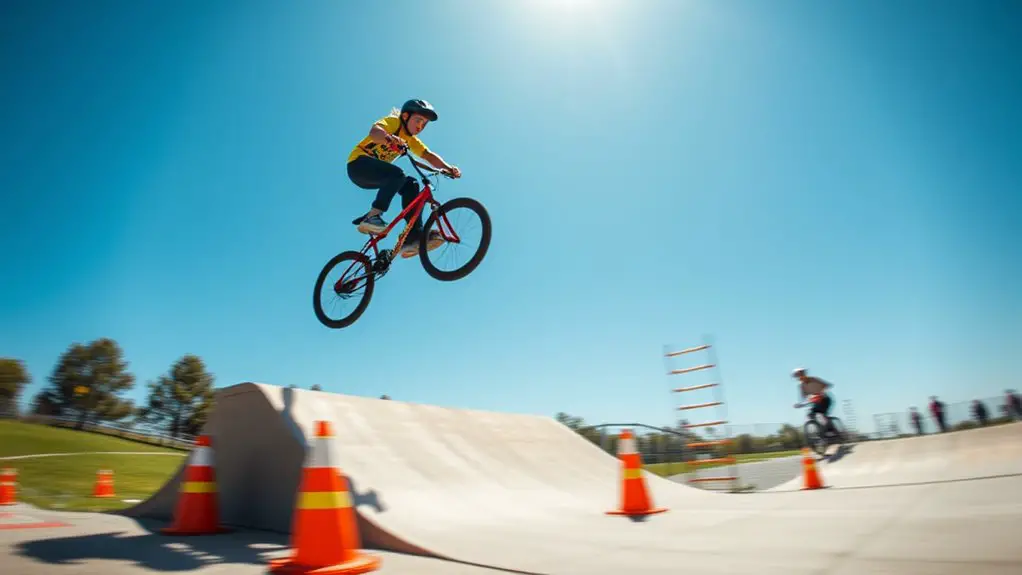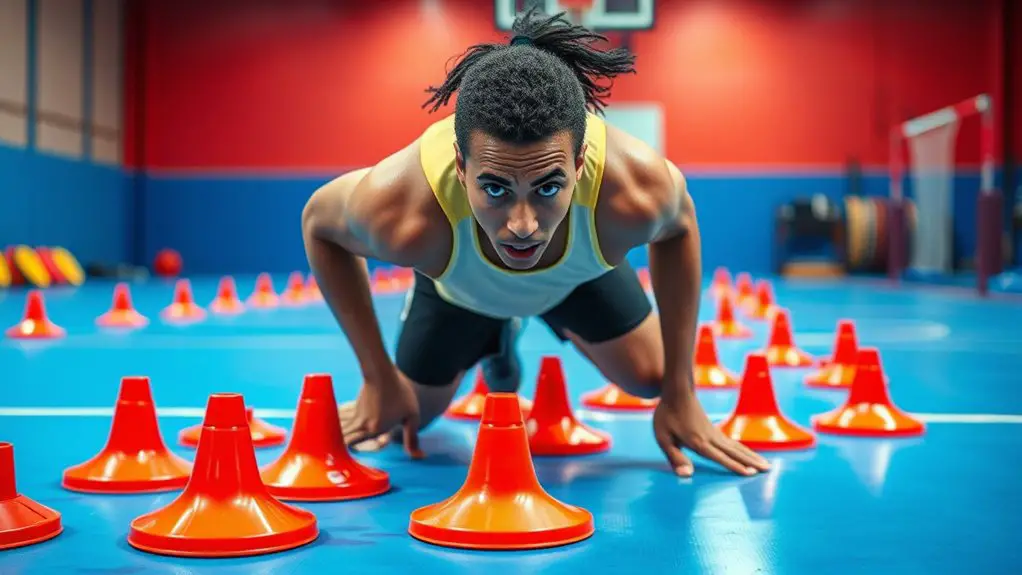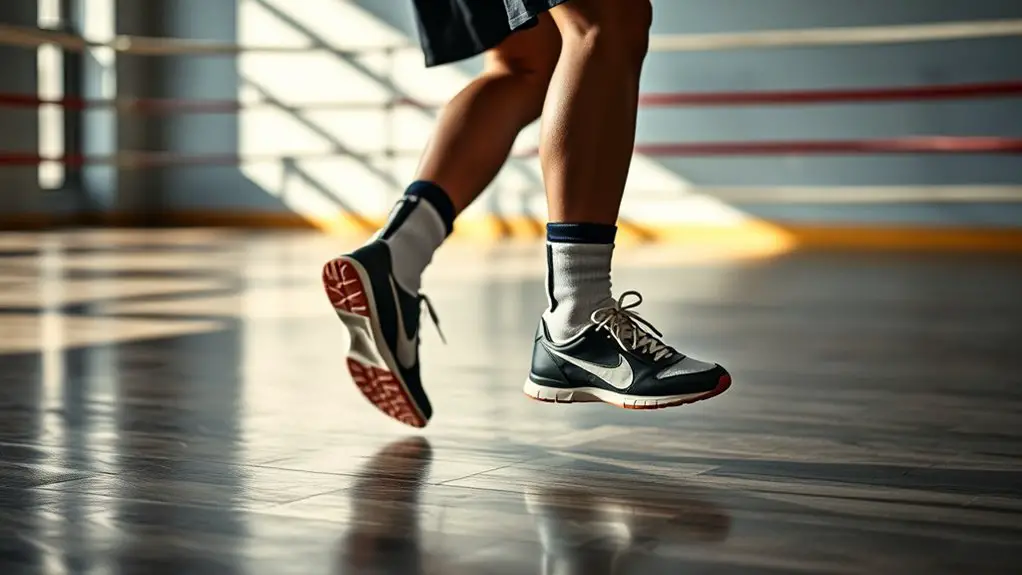To train for better agility in BMX racing, focus on exercises like balance training, plyometric drills, and agility ladders. Incorporate cone drills for lateral movements and quick sprints for speed. Don't forget to include flexibility routines, as they enhance your range of motion and reduce injury risks. Consistency is key, so track your progress and adjust your training as needed. Discovering more about agility techniques could really elevate your performance on the track.
Understanding Agility in BMX Racing
Agility in BMX racing is essential, as it directly impacts your ability to maneuver through tight turns and obstacles efficiently. When you think of agility, it's the capacity to change direction quickly and maintain balance while you fly down the track. Understanding agility's definition is key; it's not just about speed—it's about how well you can react in dynamic situations.
By honing your agility, you'll experience a range of benefits. You'll gain better control over your bike, allowing you to navigate those tricky corners with confidence. Plus, improved agility can enhance your overall performance, letting you keep up with the competition or even push ahead. Additionally, incorporating strength training into your routine can further enhance your muscle power for those crucial directional changes.
You're seeking that exhilarating freedom on your BMX, and agility is your ticket. Embrace it, and watch as your skills elevate, giving you the thrill of riding at your best.
Key Exercises to Improve Agility
To boost your agility in BMX racing, incorporating specific exercises into your training routine is essential. Start with balance training exercises like single-leg stands or stability ball work to enhance your core stability. These moves help you maintain control while maneuvering tricky tracks. Next, plyometric drills such as box jumps or lateral hops can greatly improve your reaction time. These explosive movements train your muscles to respond quickly, which is vital in racing scenarios where split-second decisions matter.
Don't forget agility ladders! They'll sharpen your footwork and coordination, allowing for quicker, more precise movements on the bike. Additionally, proper footwork is crucial for reducing the risk of injuries and enhancing overall performance. Finally, practice quick sprints to simulate race conditions and improve your overall speed. By integrating these key exercises, you'll not only feel more free and confident on your BMX but also elevate your performance to new heights. Embrace the grind, and watch your agility soar!
Implementing Agility Drills Into Your Routine
While you may already have a solid foundation of exercises to enhance your agility, effectively implementing these drills into your routine can make all the difference. Start by dedicating specific days for agility training, allowing you to focus entirely on your skills without distractions. Incorporate an agility ladder into your warm-up to get your heart pumping and your feet moving. Practice different foot patterns, challenging yourself to increase speed with precision.
Next, add cone drills to your regimen. Set up cones in various formations and work on quick lateral movements, sharp turns, and acceleration. These drills mimic the unpredictable nature of BMX racing, helping you react swiftly during competitions. Regularly practicing agility ladder drills can significantly enhance your foot speed and coordination, which are crucial for BMX racing performance.
Aim for consistency, and don't hesitate to mix things up to keep your workouts fresh. This approach not only boosts your agility but also keeps your passion for BMX racing alive and thriving.
The Role of Flexibility in Agility
Incorporating agility drills is just one part of enhancing your performance; flexibility plays a significant role in maximizing your agility on the BMX track. When you boost your flexibility, you release a world of movement freedom, allowing for quicker shifts and sharper turns. Dynamic stretching is a fantastic way to prep your muscles, improving your range of motion and reducing injury risks. Additionally, mobility training serves as a foundation for strength and endurance, further enhancing your overall performance.
Here's a quick look at some flexibility benefits:
| Flexibility Benefits | Description |
|---|---|
| Improved Range of Motion | Allows for better bike handling |
| Enhanced Balance | Keeps you stable during jumps and turns |
| Reduced Injury Risk | Protects muscles and joints |
| Increased Power Output | Translates to faster pedaling |
| Quicker Recovery | Shortens downtime after intense rides |
Embrace stretching as part of your routine, and watch your agility soar!
Tracking Your Progress and Adjusting Training
As you work on improving your agility for BMX racing, tracking your progress and adjusting your training routine is essential for achieving your goals. Start by establishing clear progress metrics. These can include lap times, agility drills completion rates, or even feedback from your riding sessions. Regularly check in on these metrics to see where you stand and identify areas that need improvement.
Once you've gathered data, don't hesitate to make training adjustments. If a particular drill isn't yielding results, switch it up! Experiment with different exercises or intensities to keep your routine fresh and effective. Remember, agility isn't just about speed; it's about precision and control too. Incorporating cross-training benefits can also enhance your overall performance and agility in BMX racing.
Frequently Asked Questions
What Gear Is Best for Improving BMX Agility Training?
Imagine the thrill of soaring through the air, wind whipping past you as you navigate tight corners with ease. To enhance your agility drills, focus on a lightweight bike setup that allows for quick maneuvers. A responsive frame, proper tire pressure, and a comfortable saddle can make all the difference. Pair this with strategic agility drills, and you'll feel the freedom to push your limits and sharpen your skills on the track.
How Often Should I Train for Optimal Agility Gains?
To achieve ideal agility gains, you should focus on daily training, but don't forget to include recovery periods. Consistency is key, but listen to your body; overtraining can lead to injury and burnout. Mix up your workouts with drills that enhance your agility while ensuring you give yourself time to recover. This balance will keep your training enjoyable and effective, allowing you the freedom to push your limits without compromising your health.
Can Diet Impact My Agility Performance in BMX Racing?
Absolutely, diet can impact your agility performance in BMX racing. Focusing on carbohydrate timing can give you the energy boost you need right before a race, while proper hydration strategies keep you performing at your best. When you fuel your body correctly, you'll feel freer and more agile on the bike. So, make sure you're eating the right foods and staying hydrated to enhance your performance and enjoy the ride!
Are There Age Restrictions for Agility Training in BMX?
You might think age restrictions limit your training options, but that's not always the case. In BMX, there's no strict age eligibility for agility training; anyone can start at any age. Training methods can be adapted to suit your individual needs, whether you're young or more seasoned. Embrace the freedom to enhance your agility and enjoy the ride, no matter when you decide to jump into the world of BMX racing.
How Do Mental Strategies Affect Agility in BMX Racing?
Mental strategies play a huge role in your agility during BMX racing. When you use mental visualization, you can imagine yourself maneuvering the course smoothly, which helps build confidence and reduces anxiety. Focus techniques, like deep breathing or positive affirmations, keep your mind sharp and centered, allowing you to react swiftly. By mastering these strategies, you're not just racing; you're accessing your full potential and embracing the freedom of the ride.




